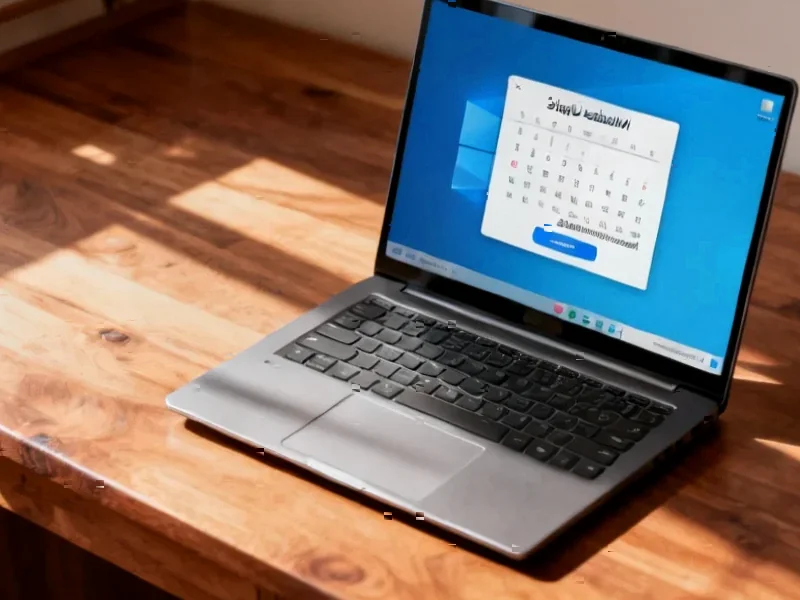According to Forbes, Microsoft has confirmed a serious Windows update mistake affecting both Windows 10 and Windows 11 users, where selecting “update and shut down” would actually trigger “update and restart” instead. The fix arrived in the October 2025 optional update (KB5067036) and specifically addresses Windows 11 25H2 Build 26200.7019 and newer versions. Microsoft is also overhauling update naming conventions to be more user-friendly while removing technical details, though this change sparked immediate backlash from IT administrators who found the simplified titles confusing. Additionally, Microsoft acknowledged a persistent driver error (0x80070103) that cannot be fully resolved, and some Windows 10 users are receiving false “end of support” notifications despite being properly enrolled in Extended Security Updates. These developments come after Microsoft stopped regular security updates for most Windows 10 users in October 2025.
The Cumulative Effect of Update Failures
What makes Microsoft’s update problems particularly concerning isn’t any single issue, but the pattern that has developed over years. The “update and shut down” bug reportedly existed for decades before being acknowledged, suggesting a concerning lack of quality control in fundamental user experience elements. When users can’t trust basic system functions to work as labeled, it undermines confidence in the entire platform. For enterprise environments, this erosion of trust has real financial consequences—IT departments spend countless hours troubleshooting what should be reliable functions, and unexpected restarts can disrupt workflows and cause data loss. The psychological impact on users who repeatedly experience these failures creates a lasting negative impression that’s difficult to overcome through marketing or feature updates.
The Enterprise vs Consumer Experience Gap
Microsoft’s attempt to simplify update names reveals a fundamental tension in serving both consumer and enterprise markets. While casual users might appreciate less technical jargon, IT administrators rely on detailed update information for proper system management and documentation. The immediate backlash that forced Microsoft to reverse course on removing dates from update titles demonstrates how critical this metadata is for professional users. This conflict highlights Microsoft’s ongoing challenge in balancing accessibility for mainstream users with the precision required by technical professionals. The company’s initial misstep suggests they may be losing touch with their enterprise customer base’s needs in pursuit of consumer-friendly simplifications.
Windows 10 EOL Complications
The false “end of support” notifications affecting properly configured Windows 10 Enterprise systems reveal deeper issues with Microsoft’s platform transition strategy. As the company pushes users toward Windows 11, these erroneous warnings create unnecessary panic and administrative overhead for organizations that have legitimately paid for Extended Security Updates. The confusion around which systems actually require upgrading versus those properly enrolled in ESU programs adds friction to what should be a straightforward enterprise licensing relationship. This comes at a particularly sensitive time when many organizations are still evaluating their Windows 11 migration strategies and budget allocations for hardware upgrades to meet the new operating system’s stricter requirements.
Systemic Quality Control Challenges
Microsoft’s admission that they cannot fully fix the driver error 0x80070103 points to deeper architectural issues within Windows Update. When a company of Microsoft’s resources declares a known issue unsolvable, it suggests fundamental design limitations in their update infrastructure. This creates a permanent support burden for both users and Microsoft’s own technical teams. The combination of long-standing bugs, partially fixable errors, and confusing interface changes indicates a potential breakdown in Microsoft’s quality assurance processes. As Windows continues to evolve, these accumulated technical debts become increasingly difficult to address without major architectural overhauls that could disrupt the installed base of billions of devices.
Strategic Implications for Microsoft’s Ecosystem
These update issues arrive at a critical juncture for Microsoft’s broader ecosystem strategy. With increasing competition from cloud-native alternatives and growing enterprise interest in managed device services, reliability concerns could accelerate shifts away from traditional Windows deployments. The consistency problems also create challenges for Microsoft’s AI integration ambitions, as unreliable base platforms undermine confidence in more advanced capabilities. For organizations considering their long-term desktop strategies, these recurring update problems provide additional justification for exploring alternative approaches, including virtual desktop infrastructure, browser-based applications, or competing operating systems that offer more predictable update experiences.




